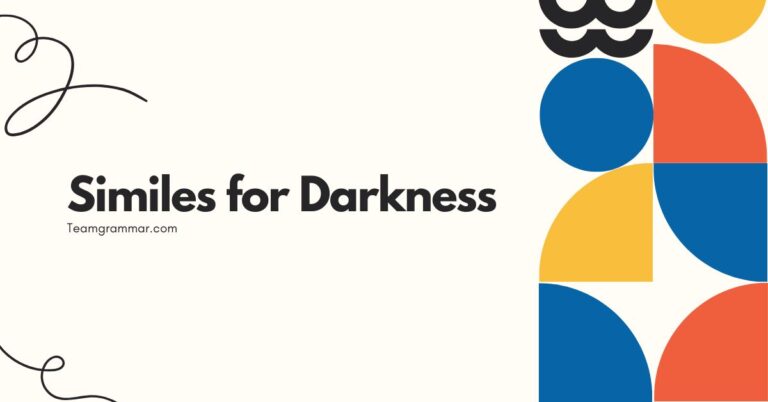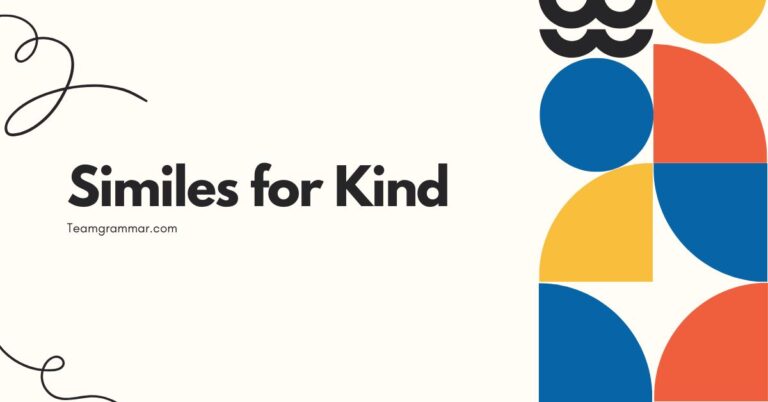45 Similes for Amazing: Enhancing Your Descriptive Language
Similes are powerful tools in the English language that allow us to paint vivid pictures with our words. By comparing something to another thing, we can convey its qualities in a more engaging and memorable way.
This article focuses on similes specifically designed to describe something “amazing,” providing you with a wide range of options to elevate your writing and speech. Understanding and using these similes effectively will greatly benefit students, writers, and anyone looking to enhance their descriptive abilities and express themselves with greater precision and flair.
Table of Contents
- Introduction
- Definition of a Simile
- Structural Breakdown of Similes
- Types of “Amazing” and Corresponding Similes
- Examples of Similes for Amazing
- Usage Rules for Similes
- Common Mistakes When Using Similes
- Practice Exercises
- Advanced Topics in Simile Usage
- Frequently Asked Questions (FAQ)
- Conclusion
Introduction
The English language is rich with figurative language, and similes are one of its most accessible and effective components. A simile directly compares two unlike things using “like” or “as,” creating a more vivid and relatable description.
When we want to express that something is truly “amazing,” a simple adjective often falls short. Similes allow us to convey the depth and impact of that amazement, making our language more engaging and memorable.
This article will explore a variety of similes that can be used to describe things that are amazing, covering different aspects of the concept and providing clear guidelines for their proper usage.
Definition of a Simile
A simile is a figure of speech that compares two dissimilar things, explicitly using the words “like” or “as.” The purpose of a simile is to illuminate a quality of one thing by associating it with another, often more familiar or evocative, thing. Similes add color, depth, and clarity to writing and speech, making descriptions more vivid and engaging.
It helps the audience understand the subject in a new light. They are a fundamental element of figurative language, widely used in literature, poetry, and everyday conversation.
Classification: Similes fall under the broader category of figures of speech, specifically within the realm of comparisons. They are distinct from metaphors, which imply a comparison without using “like” or “as.”
Function:The primary function of a simile is to enhance description. By drawing a comparison between two unlike things, it can highlight a specific quality or characteristic of the subject being described.
This can make the description more vivid, memorable, and emotionally resonant.
Contexts: Similes are appropriate in a wide range of contexts, from informal conversation to formal writing. They are commonly found in:
- Literature (novels, poems, short stories)
- Speeches and presentations
- Advertisements
- Everyday conversation
Structural Breakdown of Similes
The structure of a simile is relatively straightforward. It consists of three main components:
- The Subject: The thing being described.
- The Connecting Word: Usually “like” or “as.”
- The Object of Comparison: The thing the subject is being compared to.
The basic formula for a simile is: Subject + Connecting Word + Object of Comparison.
For example:
- Her smile was as bright as the sun. (Subject: smile, Connecting Word: as, Object of Comparison: the sun)
- The concert was like a dream come true. (Subject: concert, Connecting Word: like, Object of Comparison: a dream come true)
The effectiveness of a simile depends on the strength and relevance of the comparison. The object of comparison should be something that is easily understood and evokes a clear image or feeling in the reader’s mind.
If the comparison is too obscure or far-fetched, the simile may not be effective.
Types of “Amazing” and Corresponding Similes
The word “amazing” can encompass a wide range of positive qualities. To choose the most effective simile, it’s helpful to consider what specific aspect of “amazing” you want to emphasize.
Here are a few common types of “amazing” and corresponding simile categories:
Incredibly Beautiful
When something is amazing because of its beauty, similes can draw comparisons to visually stunning elements of nature, art, or precious materials.
Extremely Impressive
If something is amazing due to its skill, achievement, or grandeur, similes can compare it to feats of human accomplishment, powerful forces, or legendary figures.
Deeply Surprising
When something is amazing because it is unexpected or astonishing, similes can highlight the element of surprise by comparing it to sudden, impactful events or revelations.
Exceptionally Talented
When describing someone with amazing talent, similes can compare their abilities to those of renowned experts, natural phenomena, or mythical beings.
Remarkably Effective
When something is amazing because of its effectiveness or efficiency, similes can illustrate its power and impact by comparing it to well-oiled machines, unstoppable forces, or miraculous solutions.
Examples of Similes for Amazing
Here are several examples of similes for “amazing,” categorized by the type of “amazing” they describe:
Similes for Incredibly Beautiful
These similes highlight the visual splendor and attractiveness of something considered amazing. The following table contains examples of similes that describe beauty.
| Simile | Explanation |
|---|---|
| As beautiful as a sunrise over the ocean | Evokes a sense of awe and tranquility. |
| Like a masterpiece painted by a divine hand | Suggests perfection and extraordinary artistry. |
| As radiant as a thousand stars | Implies dazzling brightness and captivating allure. |
| Like a blooming lotus flower | Symbolizes purity, beauty, and spiritual awakening. |
| As breathtaking as a snow-capped mountain range | Conveys a sense of grandeur and majestic beauty. |
| Like a shimmering rainbow after a storm | Represents hope, beauty, and the promise of better things. |
| As captivating as a siren’s song | Suggests irresistible beauty and enchanting appeal. |
| Like a precious gem sparkling in the light | Implies rarity, value, and exquisite beauty. |
| As graceful as a swan gliding on water | Conveys elegance, poise, and effortless beauty. |
| Like a field of wildflowers in full bloom | Represents vibrant colors, natural beauty, and joyful abundance. |
| As stunning as a full moon on a clear night | Evokes a sense of wonder, serenity, and luminous beauty. |
| Like a perfect pearl, flawless and rare | Implies perfection, rarity, and timeless beauty. |
| As lovely as a melody that touches the soul | Conveys emotional depth, harmony, and heartfelt beauty. |
| Like a vibrant sunset painting the sky | Represents dramatic colors, breathtaking beauty, and a sense of closure. |
| As delicate as a butterfly’s wings | Suggests fragility, ethereal beauty, and fleeting moments. |
| Like a hidden garden, full of surprises and delights | Implies discovery, enchantment, and unexpected beauty. |
| As picturesque as a postcard scene | Conveys a sense of idyllic beauty and perfect composition. |
| Like a dream come to life, vivid and enchanting | Suggests fantasy, wonder, and the realization of a beautiful vision. |
| As appealing as the first bloom of spring | Implies freshness, renewal, and the promise of new beginnings. |
| Like a flawless diamond, brilliant and pure | Represents perfection, clarity, and enduring beauty. |
| As delightful as a child’s laughter | Conveys innocence, joy, and heartwarming beauty. |
| Like a peaceful oasis in the desert | Suggests respite, tranquility, and unexpected beauty in a barren landscape. |
| As majestic as an eagle soaring in the sky | Implies power, freedom, and breathtaking beauty in flight. |
| Like a symphony of colors, harmonious and vibrant | Represents unity, balance, and captivating visual beauty. |
| As captivating as the night sky filled with stars | Suggests wonder, mystery, and infinite beauty. |
Similes for Extremely Impressive
These similes emphasize the grandeur, skill, and impact of something amazing. The following table contains examples of similes that describe impressive qualities.
| Simile | Explanation |
|---|---|
| Like a skyscraper reaching for the heavens | Conveys a sense of ambition, scale, and architectural achievement. |
| As powerful as a roaring waterfall | Implies immense force, energy, and unstoppable momentum. |
| Like a conductor leading a symphony orchestra | Suggests mastery, precision, and harmonious coordination. |
| As awe-inspiring as the Great Wall of China | Represents human ingenuity, historical significance, and enduring strength. |
| Like a general commanding a vast army | Conveys leadership, strategy, and the ability to inspire and direct. |
| As impressive as a rocket launching into space | Suggests innovation, technological advancement, and limitless potential. |
| Like a master chess player anticipating every move | Implies intelligence, foresight, and strategic brilliance. |
| As monumental as the construction of the pyramids | Represents ambition, engineering prowess, and enduring legacy. |
| Like a tidal wave crashing against the shore | Conveys overwhelming force, impact, and transformative power. |
| As remarkable as a phoenix rising from the ashes | Suggests resilience, rebirth, and the ability to overcome adversity. |
| Like a CEO turning a company around | Implies leadership, strategic vision, and the ability to achieve success against all odds. |
| As grand as the opening night of an opera | Represents elegance, spectacle, and the culmination of artistic achievement. |
| Like a force of nature, unstoppable and immense | Conveys power, unpredictability, and the ability to shape the world. |
| As towering as a redwood tree in the forest | Suggests longevity, strength, and a profound connection to nature. |
| Like a surgeon performing a life-saving operation | Implies skill, precision, and the ability to make a critical difference. |
| As profound as the words of a wise sage | Represents wisdom, insight, and the ability to impart knowledge. |
| Like a detective solving a complex mystery | Conveys intelligence, perseverance, and the ability to uncover hidden truths. |
| As impactful as a historical turning point | Suggests significance, lasting consequences, and the ability to shape the future. |
| Like a seasoned explorer discovering new lands | Implies courage, curiosity, and the ability to venture into the unknown. |
| As commanding as a ship sailing through stormy seas | Represents resilience, determination, and the ability to navigate challenges. |
| Like a mountain climber reaching the summit | Conveys perseverance, achievement, and the triumph over obstacles. |
| As impactful as a groundbreaking invention | Suggests innovation, progress, and the ability to transform society. |
| Like a skilled negotiator brokering peace | Implies diplomacy, understanding, and the ability to resolve conflict. |
| As empowering as a leader inspiring change | Represents vision, motivation, and the ability to create a better world. |
| Like a virtuoso performing a complex piece | Conveys mastery, skill, and the ability to captivate and inspire. |
Similes for Deeply Surprising
These similes highlight the unexpected and astonishing nature of something amazing. The following table contains examples of similes that describe surprise.
| Simile | Explanation |
|---|---|
| Like a bolt of lightning out of the blue | Conveys suddenness, unexpectedness, and startling impact. |
| As surprising as finding a treasure chest in your backyard | Implies unexpected good fortune and delightful discovery. |
| Like a magic trick that defies explanation | Suggests mystery, wonder, and the suspension of disbelief. |
| As shocking as a plot twist in a thriller movie | Represents suspense, unexpected turns, and a sudden shift in perception. |
| Like a lottery winner realizing they’ve won | Conveys elation, disbelief, and a life-changing stroke of luck. |
| As unexpected as a rainbow in the middle of the night | Suggests rarity, wonder, and a violation of natural expectations. |
| Like a comedian delivering a perfect punchline | Implies wit, timing, and a sudden burst of laughter and surprise. |
| As startling as a jack-in-the-box popping open | Represents a sudden appearance, playfulness, and a brief moment of shock. |
| Like discovering a hidden room in an old house | Conveys mystery, intrigue, and the uncovering of a secret. |
| As baffling as a riddle with no apparent answer | Suggests complexity, confusion, and the challenge of unraveling a mystery. |
| Like waking up from a dream to find it’s real | Implies disbelief, astonishment, and the blurring of reality and fantasy. |
| As unforeseen as a meteor shower on a cloudy night | Represents a rare occurrence, a stroke of luck, and a breathtaking spectacle. |
| Like finding a long-lost friend after many years | Conveys joy, nostalgia, and an unexpected reunion. |
| As astonishing as seeing a whale breach the ocean surface | Suggests grandeur, power, and a rare glimpse of nature’s wonders. |
| Like stumbling upon a secret garden | Implies discovery, enchantment, and a hidden paradise. |
| As surprising as receiving an unexpected promotion | Conveys elation, recognition, and a sudden advancement in career. |
| Like witnessing a historical event unfold live | Suggests significance, importance, and a feeling of being part of something momentous. |
| As unexpected as a snowfall in the summer | Represents a violation of expectations, a sense of wonder, and a rare occurrence. |
| Like solving a puzzle you’ve been working on for ages | Conveys satisfaction, relief, and the joy of finally finding the solution. |
| As astonishing as seeing a rainbow in the desert | Suggests rarity, beauty, and a surprising contrast in a barren landscape. |
Similes for Exceptionally Talented
These similes highlight the skill and mastery of someone amazing. The following table contains examples of similes that describe talent.
| Simile | Explanation |
|---|---|
| Like a virtuoso playing a Stradivarius violin | Conveys exceptional skill, mastery, and artistic expression. |
| As skilled as a surgeon performing a delicate operation | Implies precision, expertise, and the ability to handle complex tasks. |
| Like a master chef creating a culinary masterpiece | Suggests creativity, artistry, and the ability to transform ingredients into something extraordinary. |
| As talented as Shakespeare writing his plays | Represents linguistic mastery, storytelling ability, and enduring literary genius. |
| Like Einstein formulating his theory of relativity | Conveys intellectual brilliance, insight, and the ability to revolutionize scientific thought. |
| As gifted as Michelangelo sculpting David | Implies artistic genius, technical skill, and the ability to create timeless masterpieces. |
| Like a seasoned athlete performing at the peak of their career | Suggests physical prowess, dedication, and the culmination of years of training. |
| As adept as a coder writing complex algorithms | Represents logical thinking, problem-solving skills, and the ability to create innovative software. |
| Like a skilled pilot landing a plane in a storm | Conveys composure, expertise, and the ability to navigate challenging situations. |
| As insightful as a therapist helping a patient heal | Implies empathy, understanding, and the ability to guide others through emotional challenges. |
| Like a chess grandmaster planning their moves | Suggests strategic thinking, foresight, and the ability to anticipate and outmaneuver opponents. |
| As eloquent as a poet reciting their verses | Represents linguistic beauty, emotional depth, and the ability to connect with others through words. |
| Like a master negotiator brokering a peace treaty | Conveys diplomacy, understanding, and the ability to resolve conflicts through communication. |
| As resourceful as a survival expert in the wilderness | Implies adaptability, ingenuity, and the ability to thrive in challenging environments. |
| Like a detective solving a complex crime | Suggests analytical skills, attention to detail, and the ability to uncover hidden truths. |
Similes for Remarkably Effective
These similes highlight the impactful results of something amazing. The following table contains examples of similes that describe effectiveness.
| Simile | Explanation |
|---|---|
| Like a well-oiled machine, running smoothly and efficiently | Conveys reliability, precision, and optimal performance. |
| As effective as a magic bullet, solving the problem instantly | Implies speed, precision, and a direct solution to a complex issue. |
| Like a domino effect, triggering a chain reaction of success | Suggests momentum, impact, and the ability to create widespread positive change. |
| As powerful as a dam controlling a river’s flow | Represents control, regulation, and the ability to manage and direct resources. |
| Like a key unlocking a hidden door, revealing new possibilities | Conveys access, opportunity, and the ability to open up new pathways. |
| As transformative as a caterpillar turning into a butterfly | Implies profound change, growth, and the realization of full potential. |
| Like a compass guiding a ship through uncharted waters | Suggests direction, guidance, and the ability to navigate complex situations. |
| As reliable as the sunrise, appearing every morning without fail | Represents consistency, dependability, and unwavering performance. |
| Like a vaccine preventing a disease, protecting against harm | Conveys prevention, protection, and the ability to safeguard against negative outcomes. |
| As impactful as a pebble creating ripples in a pond | Implies influence, reach, and the ability to create far-reaching effects. |
| Like a lighthouse guiding ships safely to shore | Suggests guidance, safety, and the ability to provide direction in challenging conditions. |
| As efficient as a computer processing complex data | Represents speed, accuracy, and the ability to handle large amounts of information. |
| Like a catalyst accelerating a chemical reaction | Conveys speed, efficiency, and the ability to speed up processes. |
| As productive as a beehive buzzing with activity | Implies teamwork, efficiency, and the ability to achieve great things through collaboration. |
| Like a magnet attracting iron filings, drawing together disparate elements | Suggests attraction, cohesion, and the ability to unite and harmonize different elements. |
Usage Rules for Similes
While similes are relatively simple to construct, there are a few rules to keep in mind to ensure that they are used effectively:
- Ensure a Clear Connection: The comparison should be clear and relevant. The object of comparison should have a quality that is directly related to the subject being described.
- Avoid Clichés: Overused similes (e.g., “as blind as a bat”) can weaken your writing. Aim for fresh and original comparisons.
- Consider Your Audience: Choose objects of comparison that your audience will understand and relate to.
- Maintain Consistency: Ensure that the tone and style of your simile are consistent with the overall tone and style of your writing.
Exceptions:Sometimes, breaking the rules can be effective, especially in creative writing. For example, using a deliberately absurd or unexpected simile can create a humorous or surreal effect.
However, it’s important to be aware of the rules before you break them.
Common Mistakes When Using Similes
Even experienced writers can sometimes make mistakes when using similes. Here are a few common errors to avoid:
- Using Metaphors Instead of Similes: Confusing similes with metaphors is a common mistake. Remember that similes use “like” or “as,” while metaphors imply a comparison.
- Creating Illogical Comparisons: The comparison should make sense. Comparing something to something completely unrelated will only confuse your readers.
- Using Clichéd Similes: Overused similes lack originality and can make your writing seem uninspired.
Correct vs. Incorrect Examples:
| Incorrect | Correct | Explanation |
|---|---|---|
| The car was speed. | The car was like a speeding bullet. | The first sentence is a metaphor attempting to be a simile. The second uses “like” to properly form a simile. |
| The idea was as green as Tuesday. | The idea was as fresh as a spring morning. | The first sentence makes an illogical comparison. The second provides a clear and relevant comparison. |
| He was as strong as an ox. | He was like a weightlifter effortlessly hoisting a barbell. | The first sentence is a clichéd simile. The second is a more original and vivid comparison. |
Practice Exercises
Test your understanding of similes with these practice exercises:
Exercise 1: Identifying Similes
Identify the similes in the following sentences:
| Question | Answer |
|---|---|
| 1. Her voice was like velvet. | Her voice was like velvet. |
| 2. The city was a jungle of concrete and steel. | (None – This is a metaphor) |
| 3. He ran as fast as the wind. | He ran as fast as the wind. |
| 4. The news hit him like a ton of bricks. | The news hit him like a ton of bricks. |
| 5. Time is a thief. | (None – This is a metaphor) |
| 6. She was as quiet as a mouse. | She was as quiet as a mouse. |
| 7. The moon was a silver coin in the sky. | (None – This is a metaphor) |
| 8. The baby slept like a log. | The baby slept like a log. |
| 9. He is a lion in battle. | (None – This is a metaphor) |
| 10. The water was as clear as glass. | The water was as clear as glass. |
Exercise 2: Completing Similes
Complete the following similes by adding an appropriate object of comparison:
| Question | Answer |
|---|---|
| 1. The music was as soothing as _____. | The music was as soothing as a gentle breeze. |
| 2. He was as brave as _____. | He was as brave as a lion. |
| 3. The cake was like _____ in my mouth. | The cake was like heaven in my mouth. |
| 4. Her eyes were as blue as _____. | Her eyes were as blue as the summer sky. |
| 5. The room was as cold as _____. | The room was as cold as ice. |
| 6. The joke was as old as _____. | The joke was as old as the hills. |
| 7. The car was as shiny as _____. | The car was as shiny as a new penny. |
| 8. The coffee was like _____ in the morning. | The coffee was like liquid gold in the morning. |
| 9. The mountain was as tall as _____. | The mountain was as tall as the sky. |
| 10. The book was as interesting as _____. | The book was as interesting as a thrilling adventure. |
Exercise 3: Creating Your Own Similes
Create your own similes to describe the following:
- A beautiful sunset
- A delicious meal
- A talented musician
- An exciting adventure
- A peaceful moment
(Answers will vary)
Advanced Topics in Simile Usage
For advanced learners, here are some more complex aspects of simile usage:
- Extended Similes: These are similes that are developed over several sentences or even paragraphs, creating a more elaborate and detailed comparison.
- Subverted Similes: These are similes that deliberately violate expectations or create a surprising twist, often for humorous or satirical effect.
- Similes in Different Genres: The use of similes can vary depending on the genre of writing. For example, similes in poetry may be more lyrical and evocative, while similes in scientific writing may be more precise and factual.
Frequently Asked Questions (FAQ)
- What is the difference between a simile and a metaphor?
A simile is a direct comparison using “like” or “as,” while a metaphor implies a comparison without using those words. For example, “He is like a lion” is a simile, while “He is a lion” is a metaphor.
- Why are similes important in writing?
Similes add color, depth, and clarity to writing. They can make descriptions more vivid, engaging, and memorable, helping readers to connect with the text on a deeper level.
- How can I avoid using clichéd similes?
The best way to avoid clichés is to think creatively and try to come up with original comparisons. Consider the specific qualities you want to emphasize and brainstorm objects of comparison that capture those qualities in a fresh and interesting way.
- Can a simile be too complex?
Yes, a simile can be too complex if the object of comparison is too obscure or difficult to understand. The comparison should be clear and relevant to the audience.
- Are similes only used in writing?
No, similes are also commonly used in spoken language. They can be a powerful tool for enhancing communication and making your speech more engaging.
- How do I choose the right simile for a particular situation?
Consider the specific qualities you want to emphasize, the tone and style of your writing, and the knowledge and experience of your audience. Choose a simile that is clear, relevant, and appropriate for the context.
- Can I use similes in formal writing?
Yes, similes can be used in formal writing, but it’s important to use them judiciously and ensure that they are appropriate for the tone and style of the piece. Avoid overly informal or colloquial comparisons.
- What makes a simile effective?
An effective simile is clear, relevant, and memorable. It should create a vivid image or feeling in the reader’s mind and help them to understand the subject in a new light.
- How can I improve my simile-writing skills?
Practice regularly, read widely, and pay attention to the similes used by other writers. Experiment with different comparisons and ask for feedback from others.
- Is there a limit to how many similes I can use in a piece of writing?
While there’s no strict limit, overuse of similes can make your writing feel cluttered and repetitive. Use them sparingly and strategically to maximize their impact.
Conclusion
Mastering the art of simile construction is a valuable skill for anyone looking to enhance their descriptive abilities. By understanding the structure, types, and usage rules of similes, you can effectively paint vivid pictures with your words and convey the depth and impact of your experiences.
Remember to choose clear and relevant comparisons, avoid clichés, and consider your audience. With practice and attention to detail, you can use similes to elevate your writing and speech, making your language more engaging, memorable, and impactful.
Embrace the power of comparison and unlock the full potential of figurative language.







